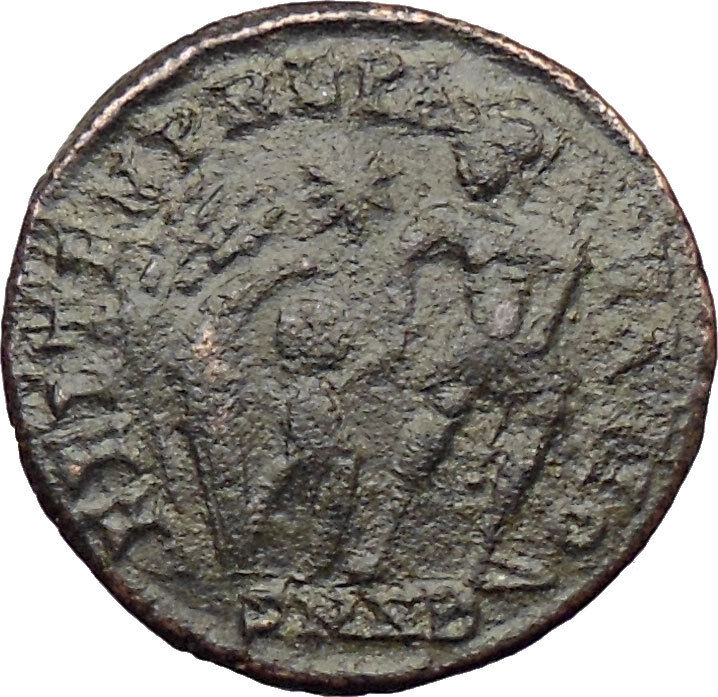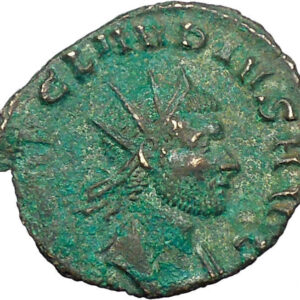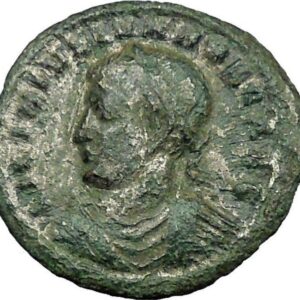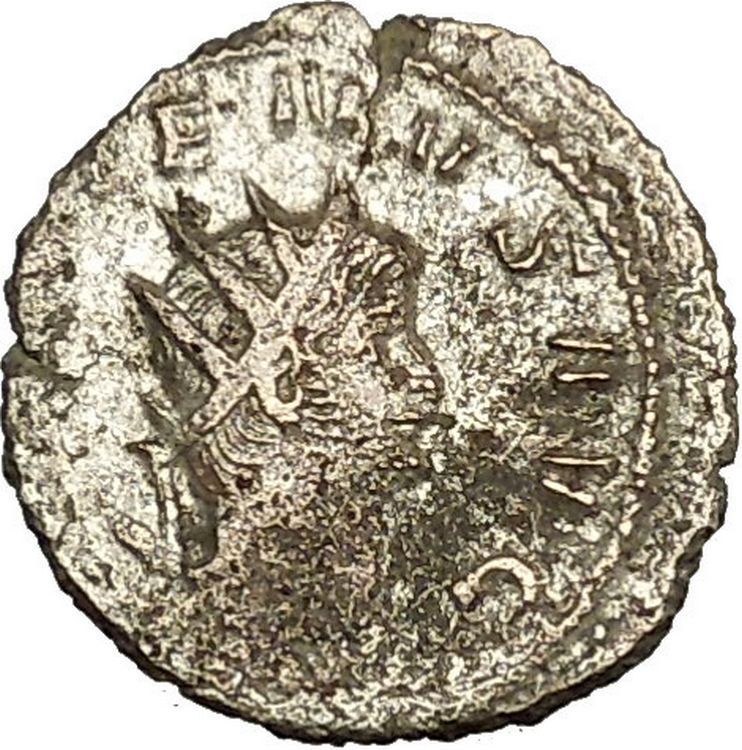|
Magnus Maximus – Roman Emperor : 383-388 A.D.
Bronze AE2 22mm (4.51 grams) Lugdunum (Lyon) mint, 2nd officina. Struck 386 A.D.
Reference: RIC IX 33; Lyon 193; LRBC 383; Sear’88 #4204
DN MAG MAXIMVS P F AVG, Pearl-diademed, draped, and cuirassed bust right.
VICTORIA AVGG, Magnus Maximus standing left, holding labarum and crowning Victory on globe; LVGS in exergue.
You are bidding on the exact item pictured, provided with a Certificate of Authenticity and Lifetime Guarantee of Authenticity.

The
labarum was a vexillum
(military standard) that displayed the “Chi-Rho” symbol ☧
, a christogram
formed from the first two Greek letters
of the word “Christ” (Greek: ΧΡΙΣΤΟΣ, or Χριστός) — Chi
(χ) and Rho
(ρ). It was first used by the Roman emperor
Constantine I
. Since the vexillum consisted of a flag suspended from the crossbar of a cross, it was ideally suited to symbolize the crucifixion of Christ
.
Ancient sources draw an unambiguous distinction between the two terms “labarum” and “Chi-Rho”, even though later usage sometimes regards the two as synonyms. The name labarum was applied both to the original standard used by Constantine the Great and to the many standards produced in imitation of it in the Late Antique
world, and subsequently.

The
Chi Rho is one of the earliest forms of christogram
, and is used by some Christians
. It is formed by superimposing the first two (capital) letters chi
and rho
(ΧΡ) of the Greek word “ΧΡΙΣΤΟΣ” = KRistos = Christ
in such a way to produce the monogram
. Although not technically a Christian cross
, the Chi-Rho invokes the authority of Jesus
, as well as symbolising his status as the Christ
.
The Chi-Rho symbol was also used by pagan
Greek
scribes
to mark, in the margin, a particularly valuable or relevant passage; the combined letters Chi and Rho standing for chrēston, meaning “good.” Some coins of Ptolemy III Euergetes
(r. 246–222 BC) were marked with a Chi-Rho.
The Chi-Rho symbol was used by the Roman emperor
Constantine I
(r. 306–337) as part of a military standard (vexillum), Constantine’s standard was known as the Labarum
. Early symbols similar to the Chi Rho were the Staurogram
( ) and the IX monogram ) and the IX monogram
( ). ).
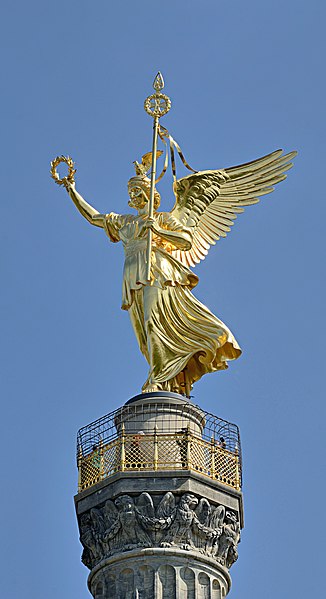
In
ancient Roman religion
, Victoria or Victory
was the
personified
goddess of victory. She is the
Roman equivalent
of the
Greek goddess
Nike
, and was associated with
Bellona
. She was adapted from the
Sabine
agricultural goddess
Vacuna
and had a
temple
on the
Palatine Hill
. The goddess
Vica Pota
was also sometimes identified with
Victoria.
Unlike the Greek
Nike
, the goddess Victoria (Latin
for “victory”) was a major part of Roman society. Multiple temples were erected
in her honor. When her statue was removed in 382 CE by Emperor
Gratianus
there was much anger in Rome. She was
normally worshiped by
triumphant
generals returning from war.
Also unlike the Greek Nike, who was known for success in athletic games such
as
chariot races
, Victoria was a symbol of victory
over death and determined who would be successful during war.
Victoria appears widely on Roman coins, jewelry, architecture, and other
arts. She is often seen with or in a
chariot
, as in the late 18th-century sculpture
representing Victory in a
quadriga
on the
Brandenburg Gate
in
Berlin
, Germany; “Il Vittoriano”
in Rome has two.
Winged figures, very often in pairs, representing victory and referred to as
“victories”, were common in Roman official iconography, typically hovering high
in a composition, and often filling spaces in
spandrels
or other gaps in architecture. These
represent the spirit of victory rather than the goddess herself. They continued
to appear after Christianization of the Empire, and slowly mutated into
Christian angels
.
Magnus Clemens Maximus (ca. 335–August
28, 388
),
also known as Maximianus and Macsen Wledig in
Welsh
, was a
Hispano-Roman
usurper
of the
Western Roman Empire
from 383 until his death, in 388, by order of Emperor
Theodosius I
.
Life
Maximus was a distinguished general who served under
Theodosius the Elder
. He certainly served with him in Africa in 373 and on
the Danube in 376. It is likely he also may have been a junior officer in
Britain during the quelling of the
Great Conspiracy
in 368. Assigned to
Britain
in 380, he defeated an incursion of the
Picts
and
Scots
in 381.
Maximus was proclaimed emperor by his troops in 383. He went to
Gaul to pursue his
imperial ambitions taking a large number of British troops with him.
Following his conquest of Gaul, Maximus went out to meet his
main opponent, Gratian
, whom he defeated near
Paris
. Gratian,
after fleeing, was killed at
Lyon on
August 25
,
383. Continuing his campaign into Italy Maximus was stopped from overthrowing
Valentinian II
, who was aged only twelve, when
Theodosius I
, the
Eastern Roman Emperor
, sent
Flavius Bauto
with a powerful force to stop him. Negotiations followed in
384 including the intervention of
Ambrose
,
Bishop of Milan, leading to an accord with Valentinian II and Theodosius I in
which Maximus was recognized as an Augustus in the west.
Maximus made his capital at Augusta Treverorum (Treves,
Trier
) in Gaul
and ruled Britain, Gaul, Spain, and Africa. He issued coinage and a number of
edicts reorganizing Gaul’s system of provinces. Some scholars believe Maximus
may have founded the office of the
Comes Britanniarum
as well. He became a popular emperor,
Quintus Aurelius Symmachus
delivered a panegyric on Maximus’ virtues. He
used barbarian forces such as the
Alamanni
to
great effect. He was also a stern persecutor of
heretics
. It
was on his orders that
Priscillian
and 6 companions became the first people in the history of
Christianity
to be executed for
heresy
, in this
case of
Priscillianism
, by other Christians (though the civil charges were for the
practice of
magic
), and their property was confiscated. These executions went ahead
despite the wishes of prominent men such as
St. Martin of Tours
. Maximus’ edict of 387 or 388 which censured Christians
at Rome for burning down a Jewish synagogue, was condemned by Bishop
Ambrose
who
said people exclaimed: ‘the emperor has become a Jew’
In 387 Maximus managed to force
Valentinian II
out of
Rome after which he
fled to Theodosius I
. Theodosius I and
Valentinian II
then invaded from the east and campaigned against Magnus
Maximus in July-August 388, their troops being led by
Richomeres
and other generals. Maximus was defeated in the
Battle of the Save
, and retreated to
Aquileia
.
Meanwhile the Franks
under
Marcomer
had taken the opportunity and invaded at the same time further weakening Maximus’
position.
Andragathius,
magister equitum
of Maximus and killer of Gratian, was defeated near
Siscia
while Maximus’ brother, Marcellinus, fell in battle at
Poetovio
. Maximus surrendered in Aquileia and although he pleaded for mercy
was executed. The Senate passed a decree of
Damnatio memoriae
against him. However, his mother and at least two
daughters were spared. Maximus’ son,
Flavius Victor
, was executed at Trier by Valentinian’s magister peditum
Arbogast
in the fall of the same year
What happened to Maximus’ family after his downfall is not
related. He is known to have had a wife, who is recorded as having sought
spiritual counsel from
St. Martin of Tours
during his time at Trier. Her ultimate fate, and even
her name, have not been passed down to history. The same is true of Maximus’
mother and daughters spared by Theodosius. One of these daughters might have
been married to Ennodius, proconsul Africae (395). Ennodius’ grandson was
Petronius Maximus
, another ill-fated emperor, who ruled in Rome for but 77
days before he was stoned to death while fleeing from the Vandals on May 24,
455. Other descendants of Ennodius, and thus possibly of Maximus, included
Anicius
Olybrius
, emperor in 472, but also several consuls and bishops such as
St. Magnus Felix Ennodius
(Bishop of
Pavia
c. 514-21).
We also encounter an otherwise unrecorded daughter of Magnus Maximus,
Sevira
, on the
Pillar of Eliseg
, an early medieval inscribed stone in Wales which claims
her marriage to
Vortigern
,
king of the Britons.
Role in British and Breton history
In
Gildas
‘s De
Excidio et Conquestu Britanniae written in the sixth century, Maximus is
attributed an important role as the man responsible for withdrawing Roman troops
from Britain on a major scale and thus leaving it open to barbarian attack. The
archaeological evidence backs up Gildas’s account in that the late fourth
century seems to have been the period when Roman troops were withdrawn from
areas like
Hadrian’s Wall
and
Segontium
, with no coins found later than 383. The earliest Welsh
genealogies give Maximus (Welsh:
Macsen/Maxen Wledig) a role as a
founding father of the dynasties of many of Welsh kingdoms such as the
Kingdom of Powys
,
Kingdom of Gwent
and the
Kingdom of Dyfed
– the sort of claims reflected in the
Pillar of Eliseg
and in lists of the
Fifteen Tribes of Wales
.
It has been argued that this role may be a result of genuine land grants and
delegation of authority by Roman authorities to local leaders such as
Vortigern
and
Padarn Beisrudd
on troop withdrawal. It also has been suggested he settled
the Déisi
and
Attacotti
in Britain.
Although it is impossible to back these ideas with any certainty, and they could
be later invention, it is obvious that a connection to Macsen was seen as highly
desirable early in Welsh history.
The ninth century
Historia Brittonum
gives another account of Maxiumus and assigns him an
important role:
The seventh emperor was Maximianus. He withdrew from
Britain with all its military force, slew Gratianus the king of the Romans,
and obtained the sovereignty of all Europe. Unwilling to send back his
warlike companions to their wives, families, and possessions in Britain, he
conferred upon them numerous districts from the lake on the summit of Mons
lovis, to the city called Cant Guic, and to the western Tumulus, that is
Cruc Occident. These are the Armoric Britons, and they remain there to the
present day. In consequence of their absence, Britain being overcome by
foreign nations, the lawful heirs were cast out, till God interposed with
his assistance.
Modern historians believe that this idea of mass British
troop settlement in
Brittany
by
Maximus may very well reflect some reality, as it accords with other historical
evidence and later Breton traditions.
Welsh legend
Legendary versions of Maximus’ career in which he marries a
Welsh princess
Helen
may have been in popular circulation in Welsh speaking areas from an
early point. Although the story of Helen and Maximus’s meeting is almost
certainly fictional, there is some evidence for the basic claims. He is
certainly given a prominent place in the earliest version of the
Welsh
Triads
which are believed to date from c. 1100 and which reflect far older
traditions. Macsen is also frequently referred to in Welsh poetry as a point of
comparison to later Welsh leaders. These legends come down to us in two separate
versions.
Geoffrey of Monmouth
According to
Geoffrey of Monmouth
‘s fictional
Historia Regum Britanniae
(ca. 1136), basis for many English and
Welsh legends, Maximian as he calls him, was a Roman senator and nephew of
Coel Hen
through his brother Ioelinus and was king of the
Brythons
following the death of
Octavius
.
Geoffrey tells this came about because Octavius, the king of the Britons, wanted
to wed his daughter to such a powerful half-Roman, half-Briton and give the
kingship of Britain as a dowry to that husband so he sent a message to Rome
offering his daughter to Maximian.
Caradocus
,
the
Duke of Cornwall
, had suggested and supported the marriage between
Octavius’s daughter and Maximian. Maximian accepted the offer and left Rome for
Britain. Geoffrey claims further that Maximian gathered an army as he sacked
Frankish
towns
along the way. He invaded Clausentum (modern
Southampton
) unintentionally and nearly fought the army of the Britons under
Conanus
before a truce was made. Following further negotiations, Maximian
was given the kingship of Britain and Octavius retired. Five years into his
kingship, Magnus Maximus assembled a vast fleet and invaded
Gaul, leaving
Britain in the control of Caradocus. Upon reaching the kingdom of
Armorica
,
he defeated the king and killed thousands of inhabitants. Before departing to
Rome, he summoned
Conanus
, the rebellious nephew of Octavius, and asked him to rule as king of
the land, which was renamed
Brittany
,
or ‘Little Britain’. Conan’s men married native women after cutting out their
tongues to preserve the purity of their language. Geoffrey of Monmouth presents
this legend to explain the Welsh name for Brittany, Llydaw, as originating from
lled-taw or half-silent. Given that Conan was well established in genealogies as
the founder of Brittany this certainly is connected to an older tradition than
Geoffrey.
Following the death of Caradocus rule of Britain as regent
passed to Dionotus
, who facing a foreign invasion appealed to Maximus who finally sent
a man named
Gracianus Municeps
with two legions to stop the attack. He killed many
thousands before the invaders fled to
Ireland
.
Maximus died in Rome
soon after and Dionotus became the official king of the Britons. Unfortunately,
before he could begin his reign, Gracianus took hold of the crown and made
himself king over Dionotus.
The Dream of Macsen Wledig
Although the
Mabinogion
tale The Dream of Macsen Wledig is written in later manuscripts than
Geoffrey’s version, the two accounts are so different that scholars agree the
Dream cannot be based purely on Geoffrey’s version. The Dream’s account also
seems to accord better with details in the Triads, so it perhaps reflects an
earlier tradition.
Macsen Wledig, the Emperor of Rome, dreams one night of a
lovely maiden in a wonderful, far-off land. Awakening, he sends his men all over
the earth in search of her. With much difficulty they find her in a rich castle
in Britain, daughter of a chieftain based at
Segontium
(Caernarfon),
and lead the Emperor to her. Everything he finds is exactly as in his dream. The
maiden, whose name is
Helen
or Elen, accepts and loves him. Because Elen is found a virgin, Macsen
gives her father sovereignty over the island of Britain and orders three castles
built for his bride. In Macsen’s absence, a new emperor seizes power and warns
him not to return. With the help of men from Britain led by Elen’s brother
Conanus
(Welsh:
Kynan Meriadec,
French
: Conan Meriadoc), Macsen marches across Gaul and Italy and
recaptures Rome. In gratitude to his British allies, Macsen rewards them with a
portion of Gaul that becomes known as Brittany.
Later literature
The prominent place of Macsen in history, Welsh legend and in
the
Matter of Britain
means he is often a character or referred to in historical
and Arthurian fiction. Such stories include
Stephen R. Lawhead
‘s
Pendragon Cycle
,
Mary
Stewart
‘s
The Hollow Hills
, and
Rudyard Kipling
‘s
Puck of Pook’s Hill
. The popular Welsh
folk song
Yma o Hyd
,
recorded by
Dafydd
Iwan
in 1981, recalls Macsen Wledig and celebrates the continued survival of
the Welsh people
since his days.
|








